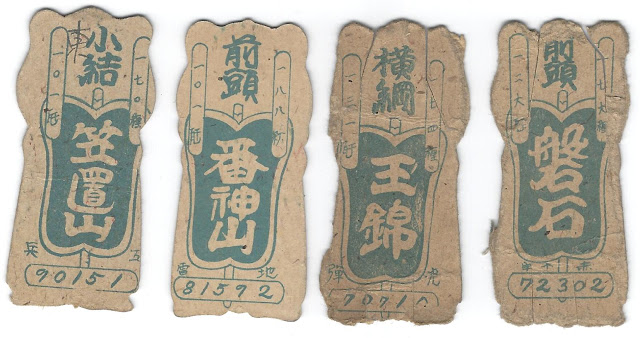NS (not scarce)--More than 1,000 copies known of most cards.
R1--between 250 and 1,000 copies known of most cards.R2--between 100 and 249 copies known of most cards.
R3--between 11 and 99 copies known of most cards.
R4--between 5 and 10 copies known of most cards.
R5--5 or fewer copies known of most cards
My approach is from a slightly different angle and I have calculated/estimated/guessed how hard it would be to find a sumo menko/card if you wanted to go out and purchase one today. My scale is from an auction or purchasing point of view and basically how long it would take for one to pop up at auction if you were looking today. He is my Availability Rating scale applied to each sumo set:
Common - Menko from this set are easy to obtain, available every month or two.
Scarce - Menko from this set show up from time to time, available a few times a year.
Rare - Menko from this set are hard to come by, available only once every few years.
Extremely Rare - Menko from this set are almost impossible to find, available only a few times in a lifetime.
Here are menko from the Extremely Rare R378: 1937 Rikishi Gunbai 5 set. In almost 20 years of searching, here are the only 4 menko that have showed up while searching.



Whoa. Four examples in twenty years? Yeah... I'd say those are extremely rare. I've always wondered with our hobby in general... just how many collectibles have been destroyed by natural disasters like floods, tsunamis, tornados, etc. Maybe there was a storage unit filled with these 1937 Rikishi Gunbai cards that was destroyed by one of the tsunamis that have hit over the years.
ReplyDeleteI often wonder about that as well, the earthquakes and wars were not kind to some of the Japanese antiques.
ReplyDeleteNatural disasters are bad enough, but one can only imagine how many things were lost when THE bombs were dropped?
DeleteThe firebombing of Tokyo in March of 1945 was probably more destructive from that point of view than the atomic bombs, just based on the populations of the cities involved.
DeleteNot that this is an important measure of loss.
The fire-bombings and bombings in general were very destructive for sure. Lots of possessions lost by many.
DeleteI think the significance of the firebombing is a bit overstated in terms of explaining the loss of a lot of pre-war antiques (and menko!)
DeleteThe firebombing was concentrated in major cities, but back then Japan's population was way less concentrated in cities than it is today. The countryside where many lived was basically unaffected by the bombings.
Probably more important were wartime paper drives. As the war progressed and turned against Japan the government started harvesting everything it could for use in the war effort. They had regular drives where people would collect materials, including paper, for use. So I would imagine that by the time the firebombing did occur (only in the closing months of the war) a lot of menko had already been recycled and there weren't many left for the bombs to destroy.
Beautiful cards!
ReplyDeleteI think I prefer your way of measuring scarcity since you are describing something which it is, within the confines of information you possess, possible to measure.
The problem I have with the Engel method is that they don't tell us how they come up with those numbers. With the R5 and R4 ones I'm fairly comfortable with their estimates because just looking at the descriptions in Prestige auctions they lay out the info on the known ones (just 3 of these are known, this is the nicest, etc).
But with R3 to R1 it seems more like they are inferring a rough estimate of the total population based on the number of cards they have seen. This is not unreasonable, but it should be explained to the reader of their guide since there are some risks of error associated with that approach, especially if the number of cards they have personally seen isn't representative of the total population (which is likely given the small number of cards out there, they may simply have not seen many copies of one card by chance and overestimated its rarity based on that, or vice versa). To assess how reliable it is we would need a bit more information on how they made these estimates.
Your method is a bit more straightforward - "this is how hard it is to find these based on my experience" is pretty easy to understand.
I appreciate the feedback. I do update my availability ratings every now and then to reflect reality especially if it has been years since I’ve seen a set or if a bunch all the sudden start showing up.
DeleteI'm astonished that there are any cards from the late 1930's at all. AFAIK there are no baseball cards from that time period. There are some collegiate cards from the early 1930's but nothing after the 1934 US tour until after the war.
ReplyDeleteSumo cards and menko are almost nonexistent in the mid to late 1940s, but baseball flourished during that time because of the occupation and sumo was stifled. Sumo flourished in the 1930s and 1950s before and after the war/occupation. Interesting to see those influences on cards.
Delete